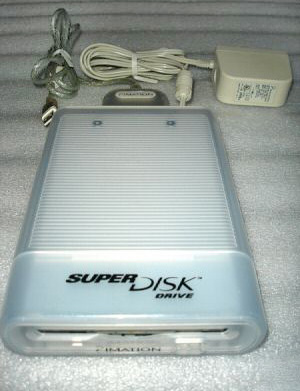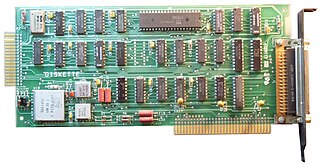Related Research Articles

The Commodore 1581 is a 3½-inch double-sided double-density floppy disk drive that was released by Commodore Business Machines (CBM) in 1987, primarily for its C64 and C128 home/personal computers. The drive stores 800 kilobytes using an MFM encoding but formats different from the MS-DOS, Amiga, and Mac Plus formats. With special software it's possible to read C1581 disks on an x86 PC system, and likewise, read MS-DOS and other formats of disks in the C1581, provided that the PC or other floppy handles the "720 kB" size format. This capability was most frequently used to read MS-DOS disks. The drive was released in the summer of 1987 and quickly became popular with bulletin board system (BBS) operators and other users.

The Commodore 1571 is Commodore's high-end 5¼" floppy disk drive, announced in the summer of 1985. With its double-sided drive mechanism, it has the ability to use double-sided, double-density (DS/DD) floppy disks, storing a total of 360 kB per floppy. It also implemented a "burst mode" that doubled transfer speeds, helping address the very slow performance of previous Commodore drives.

A floppy disk or floppy diskette is an obsolescent type of disk storage composed of a thin and flexible disk of a magnetic storage medium in a square or nearly square plastic enclosure lined with a fabric that removes dust particles from the spinning disk. Floppy disks store digital data which can be read and written when the disk is inserted into a floppy disk drive (FDD) connected to or inside a computer or other device.

Disk density is a capacity designation on magnetic storage, usually floppy disks. Each designation describes a set of characteristics that can affect the areal density of a disk or the efficiency of the encoded data. Such characteristics include modulation method, track width, coercivity, and magnetic field direction.

The SuperDisk LS-120 is a high-speed, high-capacity alternative to the 90 mm (3.5 in), 1.44 MB floppy disk. The SuperDisk hardware was created by 3M's storage products group Imation in 1997, with manufacturing chiefly by Matsushita.
In computer science, group coded recording or group code recording (GCR) refers to several distinct but related encoding methods for representing data on magnetic media. The first, used in 6250 bpi magnetic tape since 1973, is an error-correcting code combined with a run length limited (RLL) encoding scheme, belonging into the group of modulation codes. The others are different mainframe hard disk as well as floppy disk encoding methods used in some microcomputers until the late 1980s. GCR is a modified form of a NRZI code, but necessarily with a higher transition density.
Sirius Systems Technology was a personal computer manufacturer in Scotts Valley, California. It was founded in 1980 by Chuck Peddle and Chris Fish, formerly of MOS Technology and capitalized by Walter Kidde Inc. In late 1982 Sirius acquired Victor Business Systems from Kidde and changed its name to Victor Technologies. It made the Victor/Sirius series of personal computers. The company made a public stock offering in the first half of 1983, but went into Chapter 11 protection from bankruptcy before the end of 1984. The company's assets were acquired by Datatronic AB, a Swedish software/hardware distribution company headed by Mats Gabrielsson. Gabrielsson signed a distribution deal with Kyocera, which began to supply PC clones to Victor.

Atari DOS is the disk operating system used with the Atari 8-bit family of computers. Operating system extensions loaded into memory were required in order for an Atari computer to manage files stored on a disk drive. These extensions to the operating system added the disk handler and other file management features.

Cylinder-head-sector (CHS) is an early method for giving addresses to each physical block of data on a hard disk drive.
Micropolis Corporation was a disk drive company located in Chatsworth, California and founded in 1976. Micropolis initially manufactured high capacity hard-sectored 5.25-inch floppy drives and controllers, later manufacturing hard drives using SCSI and ESDI interfaces.

The Commodore 8050, Commodore 8250, and Commodore SFD-1001 are 5¼-inch floppy disk drives manufactured by Commodore International, primarily for its 8-bit CBM and PET series of computers. The drives offered improved storage capacities over previous Commodore drive models.

A floppy-disk controller (FDC) has evolved from a discrete set of components on one or more circuit boards to a special-purpose integrated circuit or a component thereof. An FDC directs and controls reading from and writing to a computer's floppy disk drive (FDD). The FDC is responsible for reading data presented from the host computer and converting it to the drive's on-disk format using one of a number of encoding schemes, like FM encoding or MFM encoding, and reading those formats and returning it to its original binary values.

The Z-89 is a personal computer produced by Zenith Data Systems (ZDS) in the early 1980s.

FileWare floppy disk drives and diskettes were designed by Apple Computer as a higher-performance alternative to the Disk II and Disk III floppy systems used on the Apple II and Apple III personal computers. The drives are named Apple 871 in service documentation, based on their approximate formatted storage capacity in kilobytes, but are most commonly known by their codename, Twiggy, after the famously thin 1960s fashion model named Twiggy.

A floppy disk is a disk storage medium composed of a disk of thin and flexible magnetic storage medium encased in a rectangular plastic carrier. It is read and written using a floppy disk drive (FDD). Floppy disks were an almost universal data format from the 1970s into the 1990s, used for primary data storage as well as for backup and data transfers between computers.

The Macintosh External Disk Drive is the original model in a series of external 3+1⁄2-inch floppy disk drives manufactured and sold by Apple Computer exclusively for the Macintosh series of computers introduced in January 1984. Later, Apple would unify their external drives to work cross-platform between the Macintosh and Apple II product lines, dropping the name "Macintosh" from the drives. Though Apple had been producing external floppy disk drives prior to 1984, they were exclusively developed for the Apple II, III and Lisa computers using the industry standard 5+1⁄4-inch flexible disk format. The Macintosh external drives were the first to widely introduce Sony's new 3+1⁄2-inch rigid disk standard commercially and throughout their product line. Apple produced only one external 3+1⁄2-inch drive exclusively for use with the Apple II series called the Apple UniDisk 3.5.
The floppy disk is a data storage and transfer medium that was ubiquitous from the mid-1970s well into the 2000s. Besides the 3½-inch and 5¼-inch formats used in IBM PC compatible systems, or the 8-inch format that preceded them, many proprietary floppy disk formats were developed, either using a different disk design or special layout and encoding methods for the data held on the disk.

The Atari 1050 was a floppy disk drive for the Atari 8-bit family home computers, released in June 1983. It was compatible with the 90 kB single-density mode of the original Atari 810 it replaced, and added a new "enhanced" or "dual density" mode that provided 130 kB. Based on a half-height Tandon mechanism, it was much smaller than the 810 and matched the styling of the new 600XL and 800XL machines.
The Durango F-85 was an early personal computer introduced in September 1978 by Durango Systems Corporation, a company started in 1977 by George E. Comstock, John M. Scandalios and Charles L. Waggoner, all formerly of Diablo Systems. The F-85 could run its own multitasking operating system called DX-85M, which included an integral Indexed Sequential (ISAM) file system and per-task file locking, or alternatively CP/M-80. DX-85M utilized a text configuration file named CONFIG.SYS five years before this filename was used for a similar purpose under MS-DOS/PC DOS 2.0 in 1983.
References
- Englisch, Lothar; Szczepanowski, Norbert (1984). The anatomy of the 1541 disk drive: A complete guide to using the commodore disk drive.